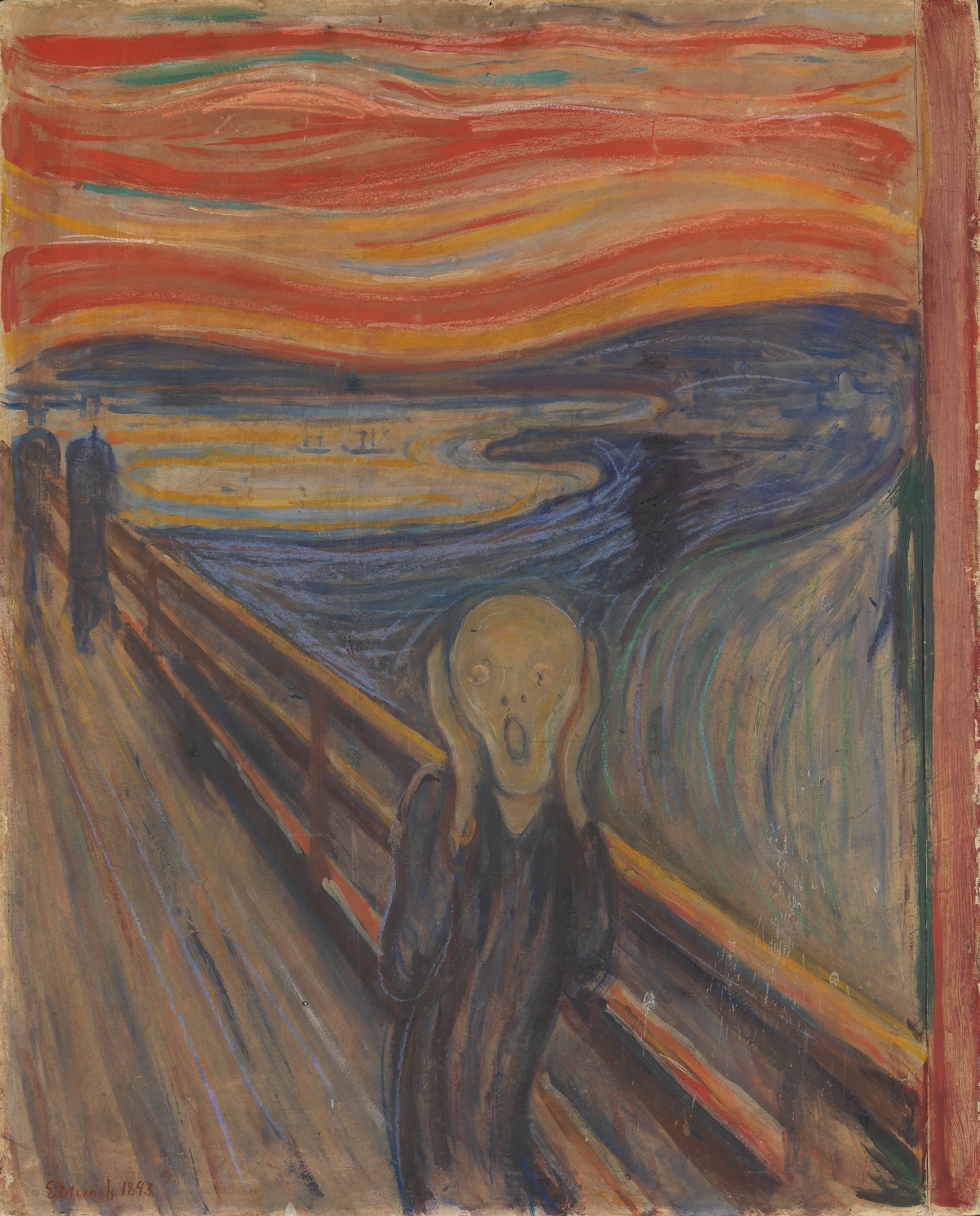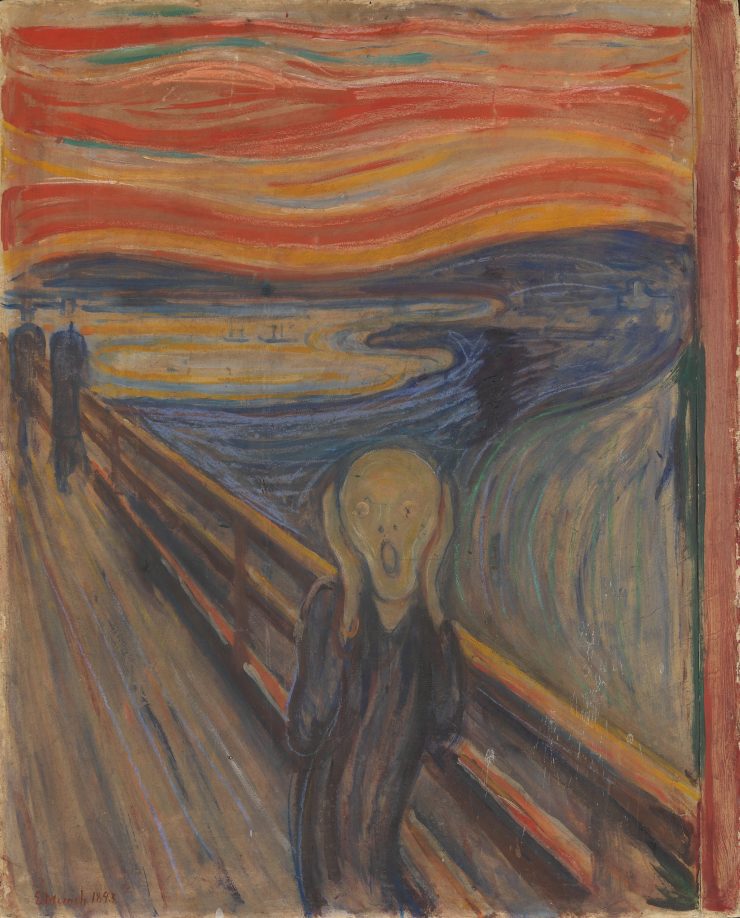
Who painted the scream?
The Scream was painted by Edvard Munch in 1893, a Norwegian Expressionist artist, who occupies a special place in the history of modern painting, especially for his unconventional, direct, and personal style. He used less saturated colors than those used by his contemporaries, but the low saturation color brings a different, heavier, more charged atmosphere to art history. Throughout the creation he addressed the theme of human destiny. He came from a family with many intellectuals and artists. He suffered the loss of his mother, then of a sister, and his father’s often violent behavior, left a deep imprint. He also began to have health problems, which is why he gave up the Polytechnic University twice. However he continued to learn drawing and the principles of painting.
Always restless, morbid and anxious, he lives loneliness both in the middle of the crowds in the big cities, but also in front of the immensity of nature. Bitterness, regret, conflict, and all the oppressive feelings rendered communicate them through elongated and melancholy curved lines, using nostalgic colors. His chromatics show that he admired the art of Vincent Van Gogh and Paul Gauguin, but the features of his art are reminiscent of the Nabis movement. Munch became known in Germany, then exerted a decisive influence on the art of this country. With The Scream he enters the world of fear and loneliness. This artwork by Munch is one of the art history’s icons of all time, a piece of great importance. The original German title of this artwork was Der Schrei der Natur (The Scream of Nature), while the Norwegian title is Skrik. The agonised face in the painting is seen as symbolising the anxiety of the human condition.
Why did munch paint the scream?
The Scream is the popular name given to a composition created by Norwegian Expressionist artist Edvard Munch in 1893. The agonised face in the painting has become one of the most iconic images of art, seen as symbolising the anxiety of the human condition.
Munch recalled that he had been out for a walk at sunset when suddenly the setting sunlight turned the clouds “a blood red”. He sensed an “infinite scream passing through nature”. Scholars have located the spot to a fjord overlooking Oslo, and have suggested other explanations for the unnaturally orange sky, ranging from the effects of a volcanic eruption to a psychological reaction by Munch to his sister’s commitment at a nearby lunatic asylum.
The famous work of art by Munch is autobiographical, an expressionistic construction based on his actual experience, while taking a walk in nature, at sunset. (https://www.edvardmunch.org/the-scream.jsp) In his diary in an entry headed “Nice 22 January 1892”, the artist wrote: „One evening I was walking along a path, the city was on one side and the fjord below. I felt tired and ill. I stopped and looked out over the fjord—the sun was setting, and the clouds turning blood red. I sensed a scream passing through nature; it seemed to me that I heard the scream. I painted this picture, painted the clouds as actual blood. The color shrieked. This became The Scream”. Munch renders it in a style which if pushed to extremes can destroy human integrity. The flowing curves of art nouveau represent a subjective linear fusion imposed upon nature. Munch included art nouveau elements in many of his works but usually only in a limited or modified way. In this depiction of a morbid experience, he allowed the foreground figure to become distorted by the subjectivized flow of nature. The scream could be interpreted as expressing the agony of the obliteration of human personality. Significantly, although it was Munch himself who underwent the experience depicted, the protagonist bears no resemblance to him or anyone else.
How many versions of The Scream are there?
Munch created various versions of The Scream, an icon of modern art, in different techniques. The Scream is undoubtedly Munch’s most famous motif and It belongs to a series of motifs that Munch developed in Berlin and Åsgårdsstrand in the 1890’s. Munch later gave the series the title Frieze of Life, and described this pictorial cycle as a poem of love, life and death. The motif has constantly been copied, caricatured and commercialised in numerous ways, and is undoubtedly one of the most famous motifs in the world of art. The popularity it has gained demonstrates its universality and shows how people take a keen interest in it, even today. The Scream is a radical and timeless expression of human fear, that exists in four forms: the first painting, in oil, tempera, and pastel on cardboard from 1893, that can be found in the National Gallery of Art in Oslo, two pastels from the same year (Munch Museum, Oslo and 1895, private collection), and a final tempera painting from 1910 (National Gallery of Art, Oslo). He also created a lithographic version in 1895, now in the collection of the University Museum of Bergen. One of the pastels from was sold for almost $120 million by Sotheby’s in 2012, and is in the private collection of Leon Black.
What makes the scream a masterpiece?
The composition is in fact a simple one, in which the artist used a minimum of forms to achieve maximum expressiveness. It consists of three main areas: the bridge, which extends at a steep angle from the middle distance at the left to fill the foreground, a landscape of shoreline, lake or fjord, and hills, and the sky, which is constructed by curving lines in tones of orange, yellow, red, and blue-green. Foreground and background blend into one another, and the lyrical lines of the hills ripple through the sky as well. Its strict linearity provides a contrast with the shapes of the landscape and the sky. The screaming figure is thus linked through these formal means to the natural realm, which was apparently Munch’s intention.
Munch’s approach to the the union of senses and had the belief that one might taste a color or smell, a musical note, which results in the visual depiction of sound and emotion. The visual music and visual poetry are here combined in the speciffic aesthetics of the artist, resulting from the curved lines and the strong colors used to accentuate the oppressive general state of the character and the artwork itself. As such, The Scream represents a key work for the Symbolist movement as well as an important inspiration for the Expressionist movement of the early twentieth century. As Munch wrote it in his notebook „it is not the chair which is to be painted but what the human being has felt in relation to it”. Through this artwork, Munch sought to express internal emotions through external forms and thereby provide a visual image for a universal human experience.

Add comment